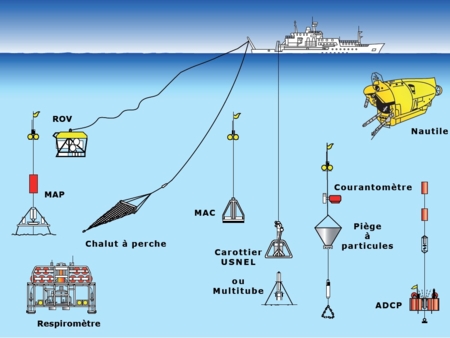Master 2 internship position at BEEP!
Our unit offers a Master 2 internship position from January to June 2023 on
Study of the diversity of microbial communities involved in the Fe-cycle at active versus inactive deep-sea hydrothermal chimneys
Scientific context
Deep-sea hydrothermal fields are complex ecosystems subjected to high temperatures, pressures, large thermal and chemical gradients and are rich in metals, particularly iron (Fe). Iron is found in its two oxidation states i.e. ferrous iron (Fe2+) and ferric iron (Fe3+) (Toner et al., 2012). Ferrous iron is found in reducing acid to neutral environments, essentially in dissolved form in fluids but also in solid form in the constituent minerals of hydrothermal edifices (pyrite, chalcopyrite, marcasite or pyrrhotite). Ferric iron is found in oxidizing and neutral media, notably in complex mineral form in vent chimneys (Fe-oxy-hydroxide, ferrihydrite, goethite, hematite). Iron is involved in the assimilative metabolism (co-factor, metalloproteins, etc.) and also in the energetic metabolism of microbial communities in deep-sea hydrothermal sources as an electron donor (Fe2+) and acceptor (Fe3+). The majority of Fe3+-reducing microorganisms identified are chemoorganotrophic, but some of them are able to grow in chemolithotrophic conditions. The bacteria identified to date are mostly affiliated with the phyla of Proteobacteria, Deferribacteres and Firmicutes and the known archaea are mainly taxa belonging to the families Archaeoglobaceae and Pyrodictiaceae (Kashefi 2002; Roh et al., 2006; Slobodkina et al., 2009, 2012). However, to date, few (hyper)thermophilic prokaryotes, capable of respiring Fe3+ have been isolated from hydrothermal edifices. Ferrous iron is an energy source structuring chemolithoautotrophic microbial communities. At acidic pH, the Fe2+ ion is stable, resists chemical oxidation and is available for biological reactions. Microbial Fe2+-oxidation is therefore mainly associated with acidic environments but this reaction is also sometimes observed at neutral pH in aquatic environments where there is no oxygen. In the current state of knowledge, the Fe2+-oxidizing taxa are affiliated to the subphylum of Zetaproteobacteria (McAllister et al., 2020). To date, only 3 bacterial strains capable of Fe2+-oxidation have been isolated from deep-sea hydrothermal sources. These Fe-based metabolisms were also highlighted using
biomarker genes as the cyc2 gene encoding for the Cyc2 Fe-oxidase and the mtrAB gene encoding for the MtrCAB complex involved in the Fe3+-reducing processus. (McAllister et al., 2021).
Study aims
While some microorganisms were isolated from deep-sea hydrothermal vents and characterized, we do not have, to date, a comprehensive view of the biological Fe-cycle in this environment. To carry out this study, the TAG and Snake Pit hydrothermal vent fields at the MAR will be sampled during the oceanographic cruise HERMINE 2 (summer 2022). Three fragments of active (reduced conditions) and inactive (oxidized conditions) hydrothermal chimney samples will be collected within a given vent field depending on the same end-member hydrothermal fluid. Those samples will allow us to compare the microbial diversity and especially the one of microorganisms involved in the Fe-cycle, between active versus inactive hydrothermal sites and according to the physico-chemical gradient. To do so, a meta-omic approach will be performed (metabarcoding and metagenomic) associated with a quantification of microorganisms involved in the Fe-cycle by quantitative PCR. The culturable diversity of microorganisms involved in Fe-cycle will also be investigated by performing enrichment cultures, isolations and physiological characterization.
Internship aims
The main goals of this Master 2 internship will be to perform:
- Metabarcoding analyses (Bacteria and Archaea). DNA extraction will be performed by mechanical and chemical lysis and libraries will be prepared for Illumina HiSeq sequencing. Sequences will then be analysed using pipeline SAMBA (Standardized and Automated MetaBarcoding Analyses workflow) on GALAXY Ifremer platform. SAMBA will allow to produce an amplicon sequence variant (ASV) table based on QIIME2 and DADA2 procedures to get a taxonomic assignment of each ASV.
- Quantitative PCR targeting functional Fe-gene markers (mtrAB or cyc2) will be performed (setting up of calibration curves; optimization of primers).
- Enrichment cultures using Fe-based media could also be performed to isolate new Fe3+-reducing and Fe2+-oxidizing microorganisms.
Candidate profile
Motivated student with training and interest in the fields of marine microbiology, microbial taxonomic and functional diversity and physiology. Curiosity and interest in meta-omics approaches and bioinformatics, wet lab molecular biology (DNA extraction and qPCR), culture experiments (anaerobic and microaerophilic conditions), and autonomy. An experience in anaerobic cultures and metabarcoding would be an advantage but is not essential.
Contacts
Please send a motivation letter, a CV and transcripts of records from the last 3 years to :
Eva POUDER: Eva.Pouder1@univ-brest.fr
Sophie MIESZKIN: Sophie.Mieszkin@univ-brest.fr
If you have any questions, please do not hesitate to contact us.
References
Kashefi, Kazem, Dawn E. Holmes, Anna-Louise Reysenbach, et Derek R. Lovley. 2002. « Use of Fe(III) as an Electron Acceptor To Recover Previously Uncultured Hyperthermophiles: Isolation and Characterization of Geothermobacterium Ferrireducens Gen. Nov., Sp. Nov ». Applied and Environmental Microbiology 68 (4): 1735-42.
McAllister, Sean M., Shawn W. Polson, David A. Butterfield, Brian T. Glazer, Jason B. Sylvan, et Clara S. Chan. 2020. « Validating the Cyc2 Neutrophilic Iron Oxidation Pathway Using Meta-Omics of Zetaproteobacteria Iron Mats at Marine Hydrothermal Vents ». MSystems 5 (1).
McAllister, Sean M., Rebecca Vandzura, Jessica L. Keffer, Shawn W. Polson, et Clara S. Chan. 2021. « Aerobic and Anaerobic Iron Oxidizers Together Drive Denitrification and Carbon Cycling at Marine Iron-Rich Hydrothermal Vents ». The ISME Journal 15 (5): 1271-86.
Roh, Y., Gao, H., Vali, H., Kennedy, D. W., Yang, Z. K., Gao, W., ... & Zhou, J. (2006). Metal reduction and iron biomineralization by a psychrotolerant Fe (III)-reducing bacterium, Shewanella sp. strain PV-4. Applied and Environmental Microbiology, 72(5), 3236-3244.
Slobodkina, G. B., T. V. Kolganova, N. A. Chernyh, J. Querellou, E. A. Bonch-Osmolovskaya, et A. I.YR 2009 Slobodkin. 2009. « Deferribacter autotrophicus sp. nov., an iron(III)-reducing bacterium from a deep-sea hydrothermal vent ». International Journal of Systematic and Evolutionary Microbiology 59 (6): 1508-12.
Slobodkina, G. B., A.-L. Reysenbach, A. N. Panteleeva, N. A. Kostrikina, I. D. Wagner, E. A. Bonch- Osmolovskaya, et A. I.YR 2012 Slobodkin. s. d. « Deferrisoma camini gen. nov., sp. nov., a moderately thermophilic, dissimilatory iron(III)-reducing bacterium from a deep-sea hydrothermal vent that forms a distinct phylogenetic branch in the Deltaproteobacteria ». International Journal of Systematic and Evolutionary Microbiology 62 (Pt_10): 2463-68.
Toner, B. M., Marcus, M. A., Edwards, K. J., Rouxel, O., & German, C. R. (2012). Measuring the form of iron in hydrothermal plume particles. Oceanography, 25(1), 209-212.







